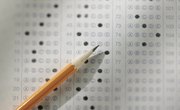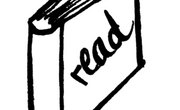Tracking a child’s learning can be a difficult process. Some school districts turn to MAP, or Measures of Academic Progress, standardized testing as a solution. Two or three times a year, the Northwest Evaluation Association, or NWEA, administers tests electronically to students in grades two through 12. The NWEA sends the results home eight to 10 weeks after the test. Learn how to interpret your child’s MAP scores so you can track her learning and have a better understanding of what she knows.
RIT Scores
The RIT, or Rasch Unit, scale is an equal interval scale based on the curriculum; it's not tied to a student's age or grade level but rather to knowledge of subject areas. The RIT scale measures growth over time. The RIT score is the middle bold number located in the column labeled “Student Score Range.” The other two numbers that fall on either side of your child’s RIT score represent the range that MAP expects the student would fall in if retested. Your child will have a RIT score for each section: math, reading and language usage. The average RIT scores for your child’s school district and the nation are displayed in columns to the right of her test scores. This will show where your child compares with her peers.
Student Growth
RIT scores are expected to increase from one MAP testing session to the next. Younger students typically show more growth than older students. The growth is highlighted in the test results under the “Student Growth” column in each section. This is your child’s growth from the last MAP test. Next to it are numbers for the typical national growth for your student's age and grade. Use this benchmark to evaluate your student’s growth. MAP growth is measured from fall testing to spring testing, so measurements can show how much the student has learned during the school year.
Student Percentile
The bold score in the “Student Percentile Range” column is the percentile rank for your child. This tells you how your child compares with other students in the same grade. The scores on either side of the bold number are the scores MAP estimates he would score if retested. If your child scored a 50, he is at the national average. If he scores in the 90 percentile, he has scored in the top 10 percent of the students that took the test nationally in his grade.
Lexile Range
During MAP testing, a child will answer questions to determine his Lexile range. The Lexile framework is a scientific scoring scale that assigns books a reading code based on their difficulty. Children are tested and assigned a Lexile range so they can clearly identify books within their ability and correct level of challenge. School libraries typically identify Lexile scores for books. You can also look up the Lexile number for books on the Lexile website. Books that are 100 Lexile points below his range will be easy for your child to read independently, while books that are 50 points above his level will be more challenging. The score is located under the "Reading Goals Performance" section. The MAP results will only show the Lexile score of the most recent test; it won't show previous results.
Related Articles
References
Writer Bio
Caroline Baldwin, a corporate communications director located in South Carolina, began writing in 1998. Her work has been published in publications across the United States and Canada including Rolling Stone, Boating Life, Waterski and Wakeboarding magazines. She holds a Bachelor of Arts in communication studies from The College of Charleston.











